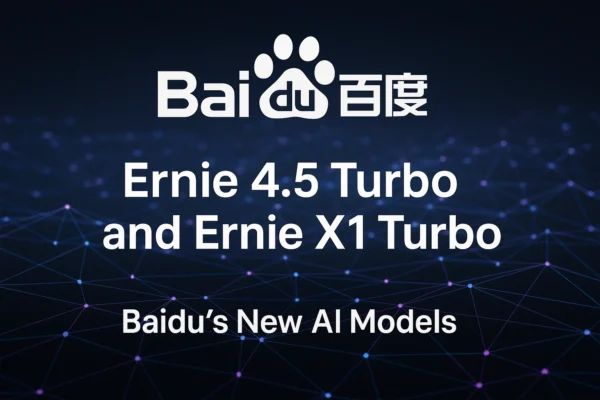
July 17, 2025
Ernie 4.5 Turbo & X1 Turbo: Baidu's Multimodal AI Models for Developers
Ernie 4.5 Turbo & X1 Turbo: Baidu's Multimodal AI Models for Developers
Can AI see, hear, and understand as we do? I wondered this when I learned about Baidu's Ernie 4.5 Turbo and X1 Turbo. AI models have excelled at reading, but can they combine text, images, audio, and video in one head? Only humans could achieve it till now.
Once Baidu released these multimodal titans, I had to join. I changed my mind about AI applications after discovering what I did. I will show you how to add Ernie 4.5 Turbo into your Python programs immediately. And I promise it is easier and cooler than you think!
What Makes Ernie 4.5 Turbo and X1 Turbo So Exciting?
While Ernie 4.5 Turbo and X1 Turbo may seem like Baidu's future language models, they are much more.
Ernie 4.5 Turbo goes beyond text. It understands and reasons with text, graphics, and audio. It can connect the dots intelligently from a picture and words, almost like a sharp human brain. Its speed and efficiency make it ideal for real-world applications.
With video analysis, X1 Turbo goes farther. Imagine giving an AI model a whole video clip and receiving smart, structured insights in seconds. The power of X1 Turbo.
Clean APIs and good documentation make both models developer-friendly. I appreciated how Baidu simplified it; no GPU clusters required only to test your first project!
How Developers Like Us Can Actually Use It
Developers dream about multimodal flexibility.
They may now create programs that handle text, vision, and audio activities without moving between models. This enables innovative concepts such as:
- Enhanced chatbots that read and view uploaded documents and listen to voice notes.
- Automated tools for creating captions or summaries for videos and podcasts.
- Apps that identify client emotions via speech and facial expressions.
- Creates digestible outputs from spoken language, images, and text using accessibility technologies.
I am excited to tell you my experience, so let's set it up!
Setting Up Ernie 4.5 Turbo for Python Projects
Starting Ernie 4.5 Turbo was delightfully easy.
First, I installed the basic Python tools I needed:
pip install requests
Next, I applied for a Baidu developer platform API key (they approve quickly). Once I got my api_key and secret_key, authentication was easy:
import requests
api_key = "your_api_key"
secret_key = "your_secret_key"
auth_url = "https://aip.baidubce.com/oauth/2.0/token"
params = {
"grant_type": "client_credentials",
"client_id": api_key,
"client_secret": secret_key
}
response = requests.post(auth_url, data=params)
access_token = response.json()["access_token"]
print("Access Token:", access_token)I was eager to engage with the model!
Processing Text and Image Together with Ernie 4.5 Turbo
Things became very awesome here. I sent Ernie a block of text and an image to observe his response.
First, I loaded an image and encoded it in base64:
import base64
def analyze_text_image(text, image_path, access_token):
request_url = f"https://aip.baidubce.com/rest/2.0/ernie/v1/multimodal?access_token={access_token}"
with open(image_path, "rb") as f:
img_data = f.read()
img_base64 = base64.b64encode(img_data).decode()
payload = {
"text": text,
"image": img_base64
}
headers = {'Content-Type': 'application/x-www-form-urlencoded'}
response = requests.post(request_url, data=payload, headers=headers)
return response.json()
# Example Usage
result = analyze_text_image("Describe this image", "sample.jpg", access_token)
print(result)The model accurately described the image, analyzing both the textand the visual content. I then get to know that this tech is game-changing.
Running Audio Analysis with Ernie 4.5 Turbo
Why limit yourself to text and visuals when audio is available?
I tried submitting a.wav audio file for Ernie to process:
def analyze_audio(audio_path, access_token):
audio_url = f"https://aip.baidubce.com/rest/2.0/ernie/v1/audio?access_token={access_token}"
with open(audio_path, "rb") as f:
audio_data = f.read()
audio_base64 = base64.b64encode(audio_data).decode()
payload = {
"audio": audio_base64,
"format": "wav"
}
headers = {'Content-Type': 'application/x-www-form-urlencoded'}
response = requests.post(audio_url, data=payload, headers=headers)
return response.json()
# Example Usage
audio_result = analyze_audio("voice_command.wav", access_token)
print(audio_result)It recognized words and hinted at the speaker's emotion; impressive!
Why Ernie 4.5 Turbo and X1 Turbo Could Shape the Future
I thought multimodal AI would become the norm after playing with these models over the weekend.
Our future apps will not merely read emails or transcribe audio notes. Like humans, they will see your images, hear your voice, watch your movies, and comprehend you across all media.
Baidu is not merely pushing research papers; they are giving developers tools like Ernie 4.5 Turbo and X1 Turbo.
Conclusion
This is your chance to design natural-looking AI apps that can see, hear, and reason. I think multimodal AI will transform personal assistants, education, content production, and healthcare. The best part? A simple API call does it all.
Sign up for an API key, open your code editor, and start building intelligent applications.
829 views
